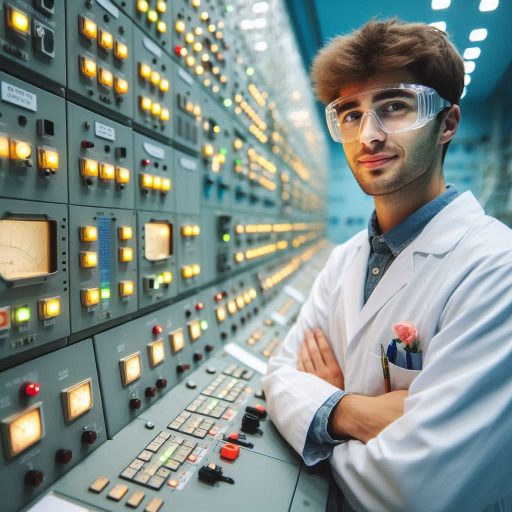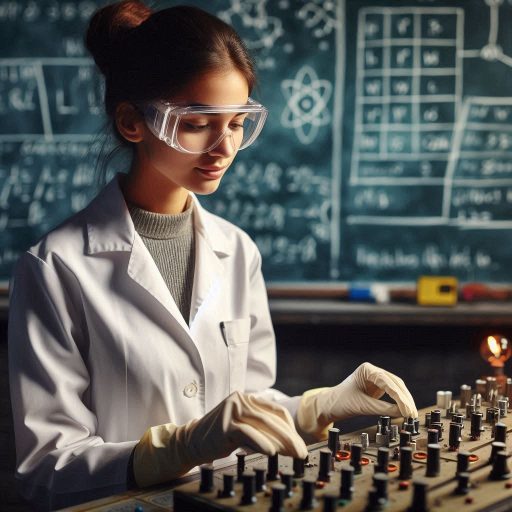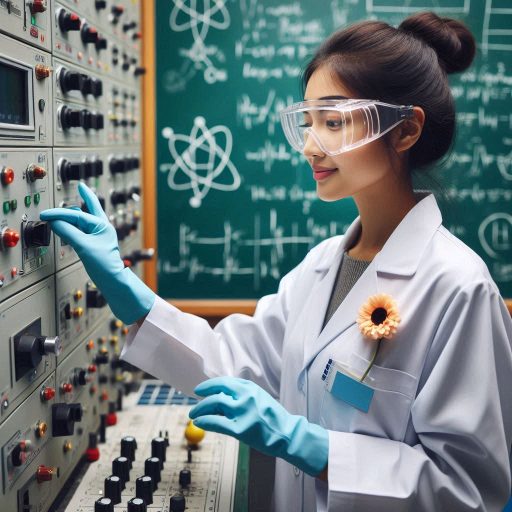Introduction
Nuclear science explores the behavior of atomic nuclei and their interactions.
It plays a crucial role in energy production, medicine, and environmental protection.
Understanding nuclear science helps address global challenges like energy sustainability and disease treatment.
Students participating in nuclear science projects gain hands-on experience and practical knowledge.
These projects encourage critical thinking and problem-solving skills.
Engaging in real-world applications of nuclear science enhances classroom learning and fosters curiosity.
Working on nuclear science projects also exposes students to advanced technology and research methods.
They learn to operate sophisticated equipment, such as radiation detectors and simulators.
This experience prepares them for future careers in science, engineering, and healthcare.
Additionally, students can collaborate with peers and professionals in the field.
Such collaborations foster teamwork and communication skills, essential for any scientific career.
Networking opportunities may arise, leading to internships and mentorships.
Participating in nuclear science projects also promotes awareness of safety and ethical considerations.
Students learn the importance of responsible practices in handling nuclear materials.
Overall, involvement in these projects cultivates a strong foundation for future academic and career success in nuclear science.
Selecting a Topic
Areas of Nuclear Science for Student Exploration
Nuclear science offers a wide range of exciting areas for students to explore.
This field encompasses various disciplines, from energy production to medicine.
By engaging in nuclear science projects, students can gain valuable insights into the applications of nuclear technology.
Each area presents unique opportunities for hands-on learning and research.
One area students can explore is nuclear energy.
This field focuses on harnessing the power of nuclear reactions for electricity generation.
Students can study the principles of nuclear fission and fusion.
They can also investigate how nuclear power plants operate and their role in the energy landscape.
Understanding the benefits and challenges of nuclear energy can spark interest in sustainable practices.
Radiation is another compelling area within nuclear science.
Students can delve into the different types of radiation and their properties.
They can study the effects of radiation on living organisms and the environment.
Projects can involve measuring radiation levels in various settings using detectors.
This practical experience provides a deeper understanding of radiation safety and its implications.
Nuclear medicine also presents fascinating project opportunities.
This field combines nuclear science with healthcare to diagnose and treat diseases.
Students can explore how radioactive isotopes are used in medical imaging.
They can also investigate therapies that use radiation to target cancer cells.
Understanding these applications highlights the critical role of nuclear science in modern medicine.
Specific Project Ideas in Nuclear Science
- Nuclear Energy Models: Students can create scale models of nuclear power plants.
They can demonstrate the processes of nuclear fission and energy generation.
This project encourages creativity while reinforcing scientific concepts. - Radiation Detection Experiment: Students can design experiments to measure background radiation in their environment.
They can use Geiger counters to collect data.
Analyzing results can lead to discussions about radiation sources and safety. - Radioactive Decay Simulation: Students can conduct a simulation to understand radioactive decay.
Using simple materials, they can model the decay process and half-life concepts.
This hands-on approach fosters comprehension of complex ideas. - Nuclear Medicine Case Study: Students can research a specific case in nuclear medicine, such as PET scans.
They can present their findings on how these scans work and their clinical applications.
This project highlights the intersection of nuclear science and healthcare. - Environmental Impact Assessment: Students can investigate the environmental impact of nuclear energy production.
They can study waste management and the safety measures in place at nuclear facilities.
This research promotes critical thinking about energy sources and environmental stewardship. - Fusion Research Presentation: Students can explore the principles of nuclear fusion.
They can create presentations on ongoing research, such as the ITER project.
This project introduces students to global scientific collaboration and future energy solutions.
Nuclear science projects offer students diverse opportunities to explore this fascinating field.
Areas like nuclear energy, radiation, and nuclear medicine provide rich topics for research and hands-on activities.
Specific project ideas, such as creating models, conducting experiments, and researching case studies, encourage engagement and learning.
By participating in nuclear science projects, students can develop a deeper understanding of nuclear technology and its real-world applications.
This knowledge can inspire future careers in science, technology, engineering, and mathematics (STEM) fields.
Read: U.S. Cities with the Most Opportunities for Environmental Scientists
Research and Background Study
Importance of Thorough Research Before Starting the Project
Thorough research is crucial before starting any nuclear science project.
A solid foundation of knowledge sets the stage for success.
Students should familiarize themselves with nuclear science concepts, terminologies, and recent advancements.
This understanding helps refine project ideas and objectives.
Begin by identifying a specific topic of interest.
Narrowing down the focus allows for more in-depth exploration.
Students can choose areas such as radiation, nuclear energy, or medical applications of nuclear science.
A clear focus will guide the research process and project development.
Reading scientific literature is an essential part of the research process.
Academic journals, books, and reputable websites offer valuable information.
Students should access resources like Google Scholar and JSTOR to find peer-reviewed articles.
These articles provide credible information, which enhances project quality.
Additionally, students can benefit from reviewing existing nuclear science projects.
This practice offers insights into project design, methodologies, and presentation styles.
By analyzing previous projects, students can avoid common pitfalls and develop innovative approaches.
Finally, consulting with educators or mentors can provide guidance.
Teachers often have valuable experience and can help refine project ideas.
They can suggest additional resources and provide feedback throughout the research process.
Resources and Tools for Effective Research
Many resources and tools are available to assist students in conducting effective research.
Online databases and libraries offer access to a wealth of information.
Students can use university libraries, public libraries, or online platforms for research materials.
Websites like the International Atomic Energy Agency (IAEA) and the U.S. Nuclear Regulatory Commission (NRC) provide reliable information.
These organizations publish reports, guidelines, and research findings on nuclear science topics.
Their resources can enhance students’ understanding of nuclear safety and regulations.
Students should also utilize educational platforms for learning.
Websites like Khan Academy and Coursera offer courses on nuclear science topics.
These courses often include videos, quizzes, and interactive content, making learning engaging and informative.
In addition, students can explore online forums and communities.
Platforms like Reddit and Stack Exchange allow students to ask questions and share knowledge.
Engaging with peers and experts can provide new perspectives and insights.
For project management and organization, students can use tools like Trello or Asana.
These applications help manage tasks, deadlines, and resources efficiently.
Organizing research materials and project components streamlines the workflow.
Finally, students should consider using simulation software or educational kits.
Many organizations offer software that simulates nuclear reactions or radiation detection.
These tools can provide hands-on experience and deepen understanding.
Thorough research is vital before starting nuclear science projects.
A solid knowledge base lays the groundwork for successful outcomes.
Utilizing various resources and tools enhances research effectiveness and project quality.
By engaging with literature, seeking mentorship, and leveraging online platforms, students can develop meaningful and impactful nuclear science projects.
These experiences will inspire curiosity and foster a deeper understanding of nuclear science’s role in society.
Read: Environmental Scientist vs. Ecologist: Roles and Differences in the US
Obtaining Materials and Equipment
Common Materials Needed for Nuclear Science Projects
Students interested in nuclear science projects require specific materials to conduct their experiments.
Understanding these materials is crucial for effective learning. Some common materials include:
- Geiger Counters: These devices measure radiation levels in the environment. Students can use them to detect radioactive sources.
- Radioactive Sources: Small, controlled sources of radiation, such as americium-241, can be used in certain experiments.
Ensure that students handle these materials under strict supervision. - Lead Shields: Lead protects students from radiation exposure during experiments. Shields are essential for safe handling of radioactive materials.
- Scintillation Detectors: These devices detect radiation using special crystals. They convert radiation energy into visible light for measurement.
- Ionization Chambers: These chambers measure ionizing radiation levels. They are suitable for educational purposes in nuclear science.
- Dosimeters: Students use dosimeters to measure exposure to radiation over time. They can track how much radiation a person has absorbed.
- Radiation Sources: Students may need radiation sources for experiments. Ensure these are safe and used in controlled settings.
While many of these materials are vital for nuclear science projects, they may not always be accessible or affordable for students.
Fortunately, several affordable and safe alternatives can facilitate learning without compromising safety.
Affordable and Safe Alternatives for Students
Many safe and budget-friendly alternatives exist for conducting nuclear science projects at home or in the classroom.
Here are some suggestions:
- Banana Peels: Students can use banana peels as a natural source of radiation.
They contain potassium-40, a naturally occurring radioactive isotope. - Common Household Items: Certain household items, like smoke detectors, contain small amounts of radioactive material.
Students can study these items under supervision to learn about radiation. - Smartphone Apps: Some apps can turn smartphones into Geiger counters.
These apps measure background radiation levels using the phone’s sensors. - Cardboard and Aluminum Foil: Students can use cardboard and aluminum foil to create simple radiation shields.
This hands-on activity helps demonstrate the concept of radiation protection. - Light Bulbs: Fluorescent bulbs contain small amounts of mercury, which emits low levels of radiation.
Students can study the principles of fluorescence and radiation safety. - Cereal: Many cereals contain potassium, which has a small amount of radioactive potassium-40.
Students can analyze and compare the levels of radioactivity in different brands. - Water: Water can serve as a simple medium for experiments.
Students can observe the effects of radiation on water molecules using household items like microwaves.
Safety Considerations
When conducting nuclear science projects, students must prioritize safety.
Always supervise experiments involving radioactive materials.
Provide proper training and guidelines for handling equipment and materials.
Encourage students to follow safety protocols, such as wearing gloves and goggles.
Ensure they understand the importance of working in well-ventilated areas.
By using affordable and safe alternatives, students can engage with nuclear science concepts without compromising safety.
These materials foster curiosity and innovation in the classroom while providing valuable hands-on experience.
Students interested in nuclear science projects need specific materials for effective learning.
While traditional materials may not always be accessible, affordable and safe alternatives exist.
By exploring these alternatives, students can conduct meaningful experiments that promote understanding and interest in nuclear science.
Through proper safety measures and creative solutions, they can gain valuable insights into this fascinating field.
Read: The Relationship Between U.S. Policy & Environmental Scientist Roles

Safety Precautions
Importance of Safety Measures in Nuclear Science Projects
When working on nuclear science projects, prioritizing safety is crucial.
Understanding the risks associated with nuclear materials helps students conduct experiments responsibly.
Radiation exposure can have severe health consequences, making safety measures essential.
Students should receive comprehensive training before handling any radioactive materials.
Educational institutions must provide clear instructions on safety protocols.
Awareness of potential hazards ensures that students can recognize and mitigate risks effectively.
Proper safety measures promote a culture of responsibility among students.
Emphasizing safety not only protects individuals but also fosters a safe learning environment.
Students should take these guidelines seriously to prevent accidents and ensure their well-being.
Guidelines for Handling Radioactive Elements Safely
- Know Your Materials: Before starting a project, students must understand the types of radioactive materials they will use.
Research the specific isotopes and their properties, including half-lives and radiation types. - Wear Protective Gear: Always wear appropriate personal protective equipment (PPE) when handling nuclear materials.
This includes lab coats, gloves, and safety goggles.
PPE helps minimize direct exposure to radiation. - Use Proper Containment: Store radioactive materials in designated containers that prevent leaks and contamination.
Use lead-lined boxes or other suitable shielding materials to contain radioactive elements. - Establish a Controlled Environment: Conduct experiments in designated laboratories equipped with safety features.
Ensure proper ventilation and access to emergency equipment, such as shower stations and eyewash stations. - Implement Shielding Techniques: Utilize shielding materials to protect yourself from radiation exposure.
Lead, concrete, and specialized plastics can effectively reduce radiation levels. - Follow Waste Disposal Protocols: Dispose of radioactive waste according to established regulations.
Students must separate waste into designated containers and label them appropriately.
This practice prevents contamination and ensures safe disposal. - Keep a Safe Distance: Maintain a safe distance from radioactive sources whenever possible.
Use tools and equipment that allow for remote handling to minimize direct exposure. - Monitor Radiation Levels: Use dosimeters to monitor radiation exposure during experiments.
Regularly check levels to ensure they remain within safe limits. - Stay Informed: Stay updated on safety regulations and best practices.
Regular training and workshops can help students understand new guidelines and techniques. - Report Incidents Immediately: Encourage students to report any accidents or safety concerns to a supervisor or instructor.
Prompt reporting allows for quick resolution and helps prevent further incidents.
Safety measures are paramount when working with nuclear materials in student projects.
By understanding the risks and adhering to guidelines, students can conduct experiments responsibly.
Emphasizing safety fosters a culture of responsibility and awareness.
Through proper training and adherence to safety protocols, students can explore the fascinating field of nuclear science.
By prioritizing safety, they protect themselves and their peers while contributing to a positive learning environment.
Read: Organizations & Associations for Environmental Scientists in the USA
Experimentation and Data Collection
Steps for Conducting Experiments and Collecting Data Accurately
Conducting nuclear science projects can be exciting and educational for students.
To ensure success, students should follow a systematic approach.
First, students need to define their research question clearly.
A well-defined question guides the entire experiment and provides focus.
Next, students should develop a detailed experimental plan.
This plan outlines the materials and methods required for the experiment.
Students must identify all necessary equipment, such as radiation detectors or spectrometers.
Having a clear plan helps streamline the process and minimizes errors.
Once the plan is established, students must gather their materials.
This step includes ensuring the quality and safety of all equipment.
Safety precautions are especially important in nuclear science experiments.
Students should always wear appropriate protective gear, such as gloves and goggles.
After gathering materials, students can begin the experiment.
They should follow their experimental plan step by step.
Consistency is vital in scientific research, so students must maintain the same conditions throughout the experiment.
As students conduct their experiments, they should collect data systematically.
Accurate data collection is crucial for reliable results.
Students can use various methods, such as spreadsheets or data logging software, to record measurements.
Regularly checking their data ensures they do not miss any important observations.
Finally, after completing the experiment, students should analyze their data.
This analysis involves interpreting results and comparing them to their original hypothesis.
Understanding the significance of their findings is essential for drawing conclusions.
Encouraging Documentation of Findings and Observations
Documenting findings and observations throughout the project is vital for student success.
Keeping a detailed record helps students track their progress and stay organized.
Students should maintain a lab notebook specifically for their nuclear science project.
In the lab notebook, students should write down all experimental procedures and results.
This record serves as a reference for their findings and allows for easy review.
Students should also note any unexpected occurrences during the experiment.
These observations can provide valuable insights during analysis.
Additionally, students should include charts and graphs to visualize their data.
Visual representations help convey complex information clearly and effectively.
Using software tools can enhance their ability to create professional-looking graphs.
Encouraging students to reflect on their processes is also essential.
They should write down their thoughts on what worked well and what could improve.
This reflection fosters critical thinking and helps students learn from their experiences.
As students complete their projects, they should prepare a comprehensive report.
This report should summarize their research question, methodology, results, and conclusions.
A well-structured report allows students to communicate their findings effectively.
Finally, students should consider presenting their projects.
Sharing their findings with peers or at science fairs enhances their communication skills.
Presentations also provide opportunities for constructive feedback and further learning.
In closing, conducting nuclear science projects offers students valuable learning experiences.
By following systematic steps for experimentation and documentation, students can achieve accurate results.
Encouraging thorough documentation and reflection throughout the project enhances their understanding and critical thinking skills.
Ultimately, these experiences foster a deeper appreciation for nuclear science and its applications.
Engaging in hands-on projects helps prepare students for future scientific endeavors.
Through dedication and organization, students can successfully explore the fascinating world of nuclear science.
Analysis and Interpretation
Analyzing Data and Drawing Meaningful Conclusions
Students involved in nuclear science projects must learn how to analyze their data effectively.
Start by organizing the collected data into clear, manageable formats.
Using spreadsheets or data visualization tools can simplify this process.
Students should identify patterns, trends, and anomalies within their datasets.
Once the data is organized, students can apply statistical methods.
Techniques such as mean, median, and standard deviation help summarize key findings.
They can also use graphs and charts to visualize their data.
These visual tools enhance understanding and make it easier to identify significant results.
Encourage students to compare their findings with existing literature.
This comparison helps contextualize their results and understand their implications.
Discussing results with peers can also provide fresh perspectives.
Engaging in group discussions encourages collaboration and deeper analysis.
Additionally, students should learn to consider the limitations of their data.
Understanding potential sources of error or bias is crucial.
This critical evaluation enhances the reliability of their conclusions.
By recognizing these limitations, students can present a more nuanced interpretation of their results.
Once the analysis is complete, students should draw meaningful conclusions.
They need to link their findings back to their original research questions.
A clear connection reinforces the significance of their work.
Encourage students to think about how their conclusions apply to real-world scenarios in nuclear science.
Encouraging Critical Thinking and Problem-Solving Skills
Critical thinking and problem-solving skills are essential for interpreting results in nuclear science projects.
Students should be encouraged to ask questions about their data and findings.
This inquiry fosters a deeper understanding of the subject matter.
Challenge students to think about alternative explanations for their results.
Encouraging them to consider different perspectives enhances their analytical abilities.
This approach helps them develop well-rounded conclusions that account for various factors.
Problem-solving skills come into play when students encounter unexpected results.
Teach students to approach these challenges systematically.
They should analyze potential causes and investigate further.
Encouraging perseverance in problem-solving builds resilience and adaptability in scientific research.
Students can also benefit from case studies in nuclear science.
Analyzing real-world examples encourages them to apply theoretical knowledge to practical situations.
Discussing past projects and their outcomes stimulates critical thinking.
This practice allows students to understand the complexities involved in nuclear science research.
Moreover, integrating collaborative projects can enhance these skills.
Working in groups encourages students to discuss and challenge each other‘s ideas.
This dialogue promotes critical thinking and collective problem-solving.
By engaging in collaborative efforts, students learn to value diverse viewpoints.
In summary, analyzing data and drawing meaningful conclusions are vital skills for students in nuclear science projects.
By organizing and visualizing their data, students can identify trends and patterns.
Encouraging them to compare findings with existing literature enhances their understanding.
Promoting critical thinking and problem-solving skills further enriches the learning experience.
By challenging students to question their results and consider alternative explanations, they develop stronger analytical abilities.
Engaging in discussions and collaborative projects fosters a supportive learning environment.
These skills will serve students well in their future careers in nuclear science and related fields.
By cultivating these abilities, educators can empower students to become innovative thinkers and problem solvers.
Uncover the Details: Toxicology in Forensic Science: What You Need to Know
Transform Your Career Today
Unlock a personalized career strategy that drives real results. Get tailored advice and a roadmap designed just for you.
Start NowPresentation and Communication
Importance of Presenting Findings Effectively
Presenting findings effectively is crucial in nuclear science projects for students.
Clear communication helps convey complex information to diverse audiences.
Whether sharing with classmates or a panel of judges, strong presentation skills matter.
An effective presentation can engage your audience and spark interest in your topic.
Moreover, presenting well demonstrates your understanding of the subject.
When you communicate clearly, you show mastery of your research.
This can lead to better grades and opportunities for future projects.
Additionally, effective presentations can open doors for networking and collaboration in the field.
Lastly, mastering presentation skills prepares students for future careers.
Professionals in nuclear science often need to present research findings.
Developing these skills early on creates a strong foundation for future success.
Tips on Creating Visual Aids
Creating effective visual aids enhances your presentation significantly.
Start by ensuring your visuals complement your spoken content.
Use graphs, charts, and images to illustrate complex concepts clearly.
Visuals should simplify information, making it easier for your audience to grasp key points.
Choose a clean, readable design for your slides.
Limit text and use bullet points to highlight essential information.
Avoid clutter and distractions in your visuals.
A simple layout helps keep your audience focused on your message.
Use high-quality images and graphics that relate directly to your research.
Ensure that any graphs or charts are clearly labeled and easy to understand.
Colors should be consistent and enhance readability rather than distract.
Consider incorporating multimedia elements, such as videos or animations.
These can make your presentation more engaging and dynamic.
However, use them sparingly to avoid overwhelming your audience.
Delivering Presentations Confidently
Confidence plays a crucial role in delivering effective presentations.
Start by practicing your speech multiple times before the actual presentation.
Familiarize yourself with the content and flow of your presentation.
Rehearsing helps reduce anxiety and boosts your confidence.
When delivering your presentation, maintain eye contact with your audience.
This connection helps engage listeners and keeps their attention.
Avoid reading directly from your notes or slides; instead, speak naturally and confidently.
Use body language to enhance your message.
Stand up straight, use gestures, and move around the stage if possible.
Engaging your audience with movement creates a more dynamic presentation.
Practice controlling your pace and tone while speaking.
Speak clearly and at a moderate pace to ensure understanding.
Pausing briefly between key points allows your audience to absorb the information.
Finally, be prepared for questions from your audience.
Anticipating potential questions shows your mastery of the topic.
Responding confidently to questions demonstrates your expertise and helps build credibility.
Presenting findings effectively is vital for students working on nuclear science projects.
Strong presentation skills not only improve communication but also prepare students for future careers.
By creating engaging visual aids and delivering presentations confidently, students can effectively share their research.
Mastering these skills will enhance learning experiences and create a lasting impact on audiences.
With practice and dedication, students can become effective communicators in the field of nuclear science and beyond.
You Might Also Like: Public Health vs. Epidemiology: Career Choice Guide
Future Implications and Next Steps
Impact of Students’ Nuclear Science Projects on Their Academic and Career Paths
Students’ nuclear science projects can significantly impact their academic journeys.
These projects foster critical thinking, problem-solving, and research skills.
Engaging in hands-on experiments helps students understand complex scientific concepts.
This practical experience can enhance their academic performance in science courses.
Completing a nuclear science project also builds confidence.
Students gain valuable experience presenting their findings to peers and educators.
This public speaking practice prepares them for future academic and professional presentations.
Moreover, successful projects can lead to recognition, scholarships, or awards, boosting students’ resumes.
Many students discover a passion for nuclear science through projects.
This newfound interest can influence their future academic choices.
Students may decide to pursue degrees in nuclear engineering, physics, or environmental science.
Engaging in nuclear science projects helps students identify their career aspirations early.
Networking opportunities arise from participating in these projects.
Students often collaborate with mentors, educators, and professionals in the field.
These connections can lead to internships and research opportunities.
Establishing a professional network early can benefit students in their future careers.
Furthermore, students can use their project findings as a stepping stone.
They may present their research at science fairs or conferences.
This exposure can attract the attention of universities and employers.
Overall, nuclear science projects serve as a powerful catalyst for academic and career growth.
Ways for Students to Further Pursue Their Interest in Nuclear Science
Students can take several steps to deepen their interest in nuclear science beyond their projects.
First, they should seek out internships or volunteer opportunities.
Many research institutions and universities offer programs for high school and college students.
Gaining practical experience in a lab setting enhances their understanding of nuclear science.
Second, students can join science clubs or organizations.
Many schools and universities have clubs focused on STEM fields.
These clubs often host events, workshops, and guest speakers.
Participating in these activities can expand students’ knowledge and connections in the field.
Third, students should consider attending conferences and seminars.
Events related to nuclear science provide valuable learning opportunities.
They allow students to hear from experts and network with professionals.
Many conferences also offer student scholarships to attend, making them more accessible.
Reading scientific journals and articles can further deepen students’ understanding.
Keeping up with recent advancements in nuclear science exposes them to current research trends.
This knowledge can spark new ideas for future projects and studies.
Additionally, students can explore online courses and webinars.
Many universities and organizations offer free or low-cost online resources.
These courses can introduce students to specialized topics within nuclear science.
Lastly, students should reach out to professionals in the field.
Informational interviews can provide insights into various career paths.
Connecting with nuclear scientists can inspire students and guide their educational choices.
On a final note, students’ nuclear science projects can profoundly influence their academic and career trajectories.
These projects foster essential skills, confidence, and networking opportunities.
By pursuing additional avenues, students can further explore their passion for nuclear science.
Engaging in internships, joining clubs, attending events, and seeking mentorship will enrich their understanding and open doors for future success.
Uncover the Details: Future Trends in Biomedical Engineering Careers
Find Out More: Microbiologist Certification and Licensing Requirements
Conclusion
Engaging in nuclear science projects provides students with valuable hands-on experience and deepens their understanding of complex concepts.
These projects allow students to apply theoretical knowledge in real-world scenarios, enhancing their problem-solving skills and critical thinking.
By working on nuclear science projects, students gain insight into energy production, radiation safety, and environmental protection.
These experiences prepare them for future careers in science, technology, engineering, and mathematics (STEM) fields, particularly in nuclear science.
It also fosters curiosity and innovation, motivating students to explore new ideas and contribute to scientific advancements.
Supporting STEM education is crucial for nurturing the next generation of scientists.
Encouraging young minds to pursue nuclear science can lead to breakthroughs in energy, healthcare, and environmental sustainability.
Schools, institutions, and organizations can play a vital role by providing resources, mentorship, and opportunities for students to engage in meaningful projects.
Promoting STEM education ensures that young scientists have the skills and knowledge needed to address future challenges.
Investing in programs that allow students to participate in nuclear science projects can inspire them to pursue careers in this critical field.
[E-Books for Sale]
The Big Book of 500 High-Paying Jobs in America: Unlock Your Earning Potential
$19.99 • 500 High-Paying Jobs • 330 pages
Explore 500 high-paying jobs in America and learn how to boost your career, earn more, and achieve success!
See All 500 High-Paying Jobs of this E-Book
1001 Professions Without a Degree: High-Paying American Jobs You Can Start Now
$19.99 • 1001 Professions Without a Degree • 174 pages
Discover 1001 high-paying jobs without a degree! Unlock career tips, skills, and success strategies for just $19.99!




